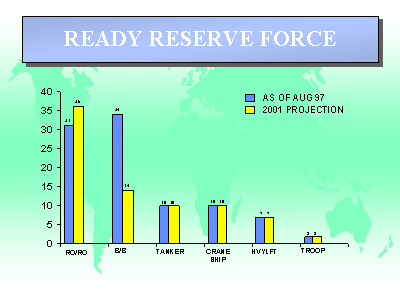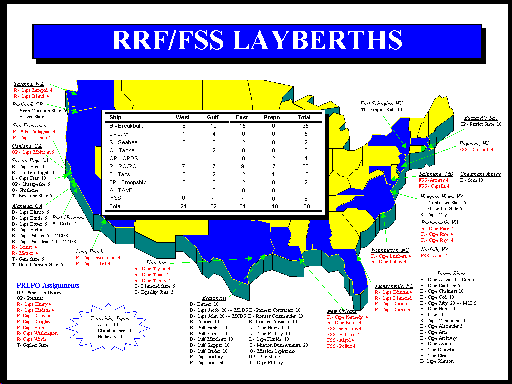





They are crewed by Maritime Administration (MARAD) personnel in an increased state of readiness that would permit their activation within four, five, ten and twenty days to meet surge military sealift requirements in the event of war. The highest priority vessels, which are all Roll-on/Roll-off (RO/RO) ships, are maintained in a status which permits reliable activation within 4 or 5 days at their berth sites, allowing expedited loading of critical surge DOD equipment. These vessels have Reduced Operating Status (ROS) crews of merchant mariners aboard carrying out a planned maintenance program. The ROS crews become a part of the operating crew that serves on the activated vessels. The outport and ROS crew provisions greatly enhance the probability of successful activation as has been demonstrated in all recent vessel call-ups. RRF vessels have consistently exceeded activation requirements. When activated, RRF ships come under the operational control of the Military Sealift Command, and are crewed by civilian American seafarers whose normal jobs are aboard the tankers, grain carriers, containerships and other US-flag merchant ships serving the nation's domestic and foreign commerce. More than 3,100 merchant mariners would be required to crew all 98 ships.
MARAD carries on a program of planned periodic activation of RRF vessels. High priority vessels perform an annual sea trial (4 and 5 day readiness status vessels). Lesser priority vessels perform sea trials in alternate years consistent with their particular readiness status. This program was established to further enhance the probability of successful activation by providing a real time insight into the material condition of the vessels. This enables MARAD to make timely maintenance decisions and repairs and better allocate resources.| Ship Manager |
Contract Amount |
RRF Ships Assigned |
Where Located |
| Apex Marine Ship Management |
$7,870,195
|
Cape Juby Cape Taylor Cape John
|
JRRF Houston BRF
|
| Interocean Ugland Management Corp. Voorhees, N.J. |
$10,923,265 5 years
$6,257,735 $10,844,615 |
Gopher State Flickertail State Cornhusker State Cape Mendocino Comet Cape Fear Wright |
Prepositioning Ship Cheatham Annex, Va. Cheatham Annex JRRF NAS Alameda, Calif. SBRF Baltimore |
| Keystone Shipping Services, Inc. Bala Cynwyd, Pa. |
$9,575,500 5 years $9,575,500 $9,575,500 $13,822,690
|
Cape Kennedy Cape Knox Cape Victory Admiral Callaghan Cape Henry Green Mountain State |
New Orleans New Orleans Beaumont, Texas San Francisco San Francisco Bremerton, Wash. |
| Mormac Marine Enterprises, Inc. Stamford, Conn. |
$2,028,988 5 years
$4,097,519
$2,104.350 |
Lake Scan Cape Catawba Cape Lambert Cape Archway Cape Ann Mission Buenaventura |
JRRF JRRF Cheatham Annex Wilmington, N.C. Baltimore Baltimore BRF |
| Marine Transport Lines, Inc. Weehawken, N.J. |
$1,821,710 3.25 years $10,155,570 $10,155,570 $10,155,570 $1,821,710 |
Cape Cod Cape Chalmers Cape Edmont Cape Decision Cape Diamond Cape Bon |
JRRF JRRF Charleston, S.C. Charleston Charleston SBRF |
| Ocean Duchess, Inc. Houston |
$3,036,000 5 years |
Alatna Chattahoohchee Nodaway |
Tsuneishi, Japan Tsuneishi, Japan Tsuneishi, Japan |
| Patriot Contract Services, LLC Walnut Creek, Calif. |
$6,895,110 5 years $9,247,810 $8,384,140 |
Cape Breton Cape Bover Cape Blanco Cape Gibson |
Alameda, Calif. Alameda Alameda Alameda |
| Pacific-Gulf Marine, Inc Gretna, La. | $1,242,027 3.25 years $1,242,027 |
Pioneer Commander Pioneer Contractor Banner |
BRF BRF BRF |
| Sea-Land Service,Inc. Charlotte, N.C. |
$13,729,875 5 years
$9,299,650 $8,860,450 |
Cape Race Cape Ray Cape Rise Cape Washington Cape Intrepid Cape Isabel |
Portsmouth, Va. Portsmouth Portsmouth Baltimore Tacoma,Wash. Long Beach, Calif. |
| V Ships Marine, Limited Mineola, N.Y. |
$3,722,850.00 5 years
$8,458,890 $14,631,130 |
Cape Florida Cape Flattery Cape Farewell American Osprey Chesapeake Keystone State |
BRF BRF BRF Prepo San Francisco Alameda |
Key: JRRF=the James River Reserve Fleet site in Virginia.; BRF=the Beaumont, Texas, Reserve Fleet; SBRF=Suisun Bay Reserve Fleet in California; Prepo=serves as a maritime prepositioning ship for the armed forces.

